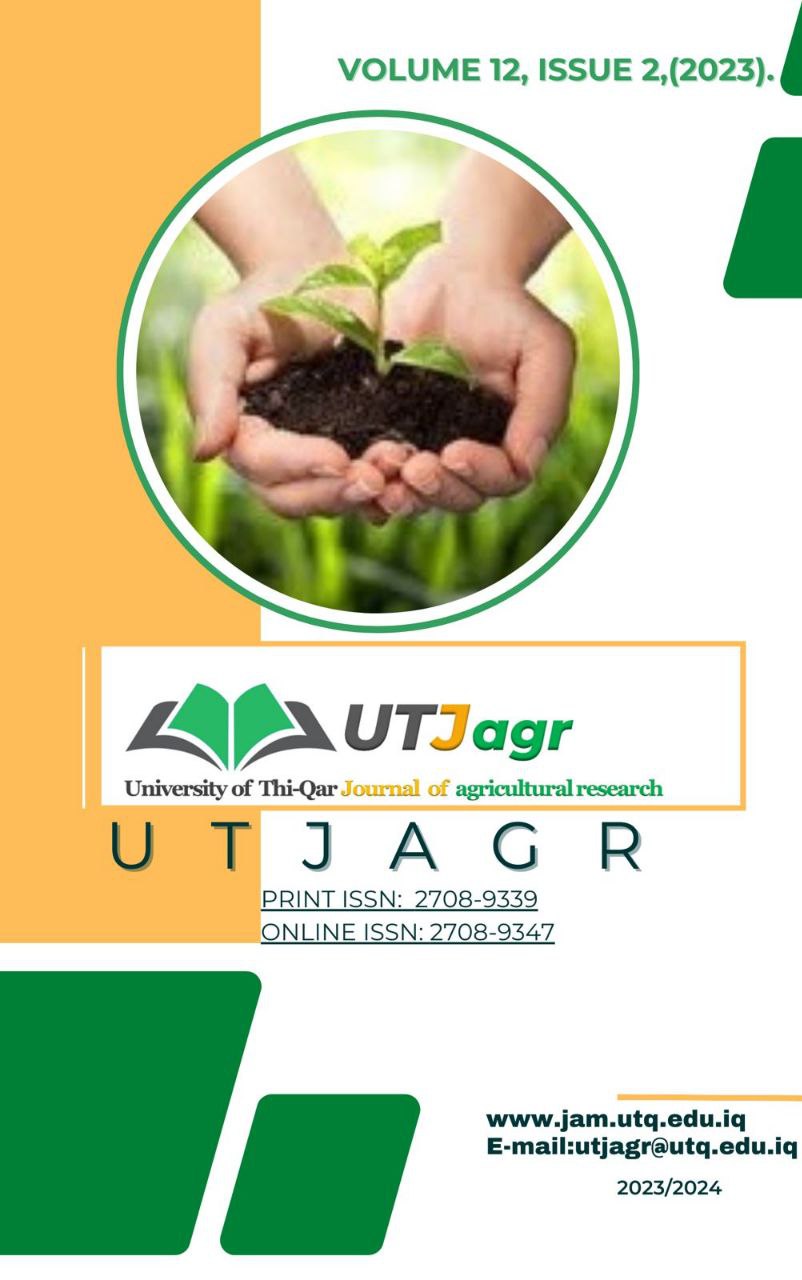The Impact of Two Types of Mycoplasma gallisepticum Vaccines on Broiler Chicken Respiratory System.
DOI:
https://doi.org/10.54174/utjagr.v12i2.273Keywords:
Mycoplasma ,poultry ,trachea, air sacs ,humoral immunity ,cellular immunity.Abstract
This study aimed to evaluate the effect of vaccinating 1-day-old broiler
chicks with two commercial vaccines such as live chronic respiratory
disease F strain (CRDF) and killed Mycoplasma gallisepticum (MG)
vaccines on the respiratory system. For this purpose, one-day-old broiler
chicks (n=120) were randomly divided into four groups; (n=30 birds
each). All groups were treated as followed: G1(CRDF): chicks were
vaccinated with live CRDF vaccine (eye drop one drop 0.03ml/dose/10 5 ),
G2 (killed MG): chicks were vaccinated with killed MG vaccine injection
with 0.3ml s.c /3 x10 10 C.F.U/ml), G3: chicks were combined vaccinated
with killed MG and CRDF live vaccines G4: served as control
unvaccinated group. The vaccination was performed at one day old in G1
(CRDF), G2(killed MG), and G3 (killed MG and live CRDF). The
histopathological changes of the trachea and air sacs were examined and
evaluated at 35 days old. The results of histopathological examination of
air sacs in the G1(CRDF) revealed various mild epithelial hyperplasia
with papillary-like growth, subepithelial lymphocytic infiltration, in G2
(killed MG), showed hyperplastic epithelial surfaces with moderate
lymphocytic infiltration mainly around congestion capillaries. While G3
(killed MG and CRDF) showed focal epithelial hyperplasia (villus-like),
and perivascular lymphocytic aggregation in laminar C.T. Whereas G4
(control) showed normal structures without any histopathological lesions.
In the trachea the histopathological changes in G1(CRDF) showed focal
lymphocytic aggregation with a follicle-like appearance, another section
showed focal epithelial and cilia loss with goblet cell hypertrophy of the
adjacent gland. G2 (killed MG) showed partial loss of thin mucosa with
mild and desquamation lymphocytic infiltration in lamina propria,
G3(killed MG and CRDF) showed diffuse mononuclear cells (MNCs)
infiltration in tracheal mucous and submucosa with evidence of cystic
dilution of adjacent gland together G4 control tracheal tissue showed
normal structure without any lesions. Finally, it was determined that
vaccination with killed MG and live CRDF vaccines caused a more
obvious immune reaction (lymphoproliferative infiltration) in the
respiratory system, including the trachea and air sac than the vaccination
with combined killed and live vaccines, while the live Mycoplasma
vaccines individually caused minor damage, particularly in the trachea.
Downloads
References
-Hennigan S, Driskell J, Ferguson-Noel N, Dluhy R, Zhao Y, Tripp R and Krause D. Detection and differentiation of avian Mycoplasmas by surface-enhanced Raman spectroscopy based on a silver nanorod array. Appl. Environ. Microbiol.2021;78:1930–1935.
- Ahmed Kadhim Abbood, & Majed Salih Himoud. (2023). Effect of rotary plow with different blades, plow cover height and different forward speed on some soil physical traits. University of Thi-Qar Journal of Agricultural Research, 12(1), 44–67. https://doi.org/10.54174/utjagr.v12i1.238
- Ahmed Kadhim Abbood, & Majed Salih Himoud. (2023). Effect of rotary plow with different blades, plow cover height and different forward speed on some soil physical traits. University of Thi-Qar Journal of Agricultural Research, 12(1), 44–67. https://doi.org/10.54174/utjagr.v12i1.238
- Mohammed A. Obid, & Jawad Kadhim Arrak. (2023). Protective Effect of Ellagic Acid on Epididymal Sperms Quality and DNA Deformity in Mature Rats Exposed to Cadmium Chloride. University of Thi-Qar Journal of Agricultural Research, 12(1), 165–180. https://doi.org/10.54174/utjagr.v12i1.247
-OIE (World Organization for Animal Health). Avian mycoplasmosis (Mycoplasma gallisepticum, M. synoviae). In Manual of Diagnostic Tests and Vaccines for Terrestrial Animals; OIE (World Organization for Animal Health): Paris, France, 2019; 2:844–859.
-Ferguson‐Noel N, Armour NK, Noormohammadi AH, El‐Gazzar M and Bradbury M. Mycoplasmosis. Diseases of poultry,2020; 907-965
-Seifi BS and Shirzad MR . Seroprevalence and risk factors of Mycoplasma gallisepticum infection in Iranian broiler breeder farms. Int J Animal Vet Adv,2012; 4:45–48.
-Raviv Z and Ley DH. Mycoplasma gallisepticum infection. In Diseases of Poultry, 13thEd. Swayne DE. editor. WileyBlackwell, Ames,2013.
- ShiferawJ, Shifara F, Tefera M, Feyisa A and Tamiru Y. Seroprevalence and Associated Risk Factors of Mycoplasma gallisepticum Infection in Poultry Farms of Hawasa and Bishoftu, Central Ethiopia. Veterinary Medicine: Research and Reports,2022; 13:101.
-Prajapati N, Subhashree J, Siju S, Manjunath GB, Reddy R,Yogisharadhya and Patil SS . Prevalence of Mycoplasma gallisepticum and Mycoplasma synovae in Poultry-India Perspective Int.J. Curr.Microbiol. App.Sci,2018; 7(5): 2213-2220.
-YadavJP, Tomar P, Singh Y and Khurana SK . Insights on Mycoplasma gallisepticum and Mycoplasma synoviae infection in poultry: a systematic review. Anim. Biotechnol,2021; 10:1–10
- Ali BH, Ali AJ, Yosif EH. Isolation and molecular characterization of Mycoplasma synoviae from infected chickens with respiratory signs. Iraqi J. Agri. Sci. 2020;51(5):1466–1473.
- Jafar NA, Noomi BS.Detection of Mycoplasma gallisepticum and Mycoplasma synoviae by using of cultural and PCR techniques. Iraqi J. Vet. Sci. 2019;33(2):469–473.
-Kempf I, Gesbert M, Bennejean G and Cooper AC . Efficacy of danofloxacin in the therapy of experimental mycoplasmoses in chicks. Research in Vet. Sci.,1992; 53 (2): 257-259.
-Asway AME, Shlaby HA, Deeb KH and Shalaby , MHM . Serological studies on Mycoplasma gallisepticum in chickens. Animal Health Research Institute,2009; 55 (120), 1-24
- Qasem JA, Al-Mouqati SA, Al-Ali EMand Ben-Haji A. Application of Molecular and Serological Methods for Rapid Detection of Mycoplasma gallisepticum Infection (Avian mycoplasmosis). Pak. J. Biol. Sci, 2015;18:81–87.
-Mera U, and Mudasir H. Prevalence of Mycoplasma gallisepticum (MG) antibodies in chicken in Sokoto, Nigeria. EAS Journal Vet. Med Sci.2019;1(5):58–59.
- Nhung N, Chansiripornchai N and Carrique Mas J. 2017. Antimicrobial resistance in bacterial poultry pathogens: a review. Front Vet Sci.4:126.
-Bottinelli M, Gastaldelli M, Picchi M, Dall’Ora A, Cristovao Borges, L, Ramírez AS,Matucci A and Catania S. The Monitoring of Mycoplasma gallisepticum Minimum Inhibitory Concentrations during the Last Decade (2010–2020) Seems to Reveal a Comeback of Susceptibility to Macrolides, Tiamulin, and Lincomycin. Antibiotics (Basel)., 2022;11, 1021.
-Kleven SH. Control of avian mycoplasma infections in commercial poultry. Avian diseases,2008; 52(3), 367-374.
-Matucci A, Stefani E, Gastaldelli M, RossiI, Grandi G, Gyuranecz M and Catania S.Molecular Differentiation of Mycoplasma gallisepticum Outbreaks: A Last Decade Study on Italian Farms Using GTS and MLST. Vaccines (Basel),2020;8(4):665.
-Elliott KEC, Branton SL, Evans JD, Magee C L and Peebles ED. Onset of the humoral immune response of layer chicks vaccinated in ova with strain F Mycoplasma gallisepticum vaccine and evidence of male-biased mortality. Poultry Science ,2022;101:101761.
-Ibrahim ZY, Ali BH, Saeed NM, and Rashid PMA. Molecular infection in broiler. The Iraqi Journal of Agricultural Sciences,2015;50:(5)1432-1438.
-Ali JE and Ali HB .Inflammatory reaction against Mycoplasma gallisepticum infection in broiler. The Iraqi Journal of Agricultural Science, 2019;50(5), 1432-1438.
-Abed AA, Al-Iedani AA and Neamah AJ. Sequencing based phylogenetic analysis of local Mycoplasma gallisepticum of broiler chickens in Al-Diwaniya Province / Iraq. Ann. Rom. Soc. Cell Bio,2021;2738-2719 (5)25 .
-Jacob R, Branton SL, Evans JD, Leigh SA and Peebles ED. Effects of live and killed vaccines against Mycoplasma gallisepticum on the performance characteristics of commercial layer chickens. Poultry Science, 2014;93(6), 1403-1409.
-Ishfaq M, Hu W, Khan MZ, AhmadI, Guo W and Li J. Current Status of vaccine research, development, and challenges of vaccines for Mycoplasma gallisepticum. Poultry Science.2020 ;99(9),4195-4202.
-Bekele L and Assefa T. Inactivated Vaccine Trial of Mycoplasma gallisepticum in Ethiopia. Open Journal of Veterinary Medicine,2018; 8, 75-85.
- Muofaq KS and Jawad AA. Immune Response and Histological Changes in Broilers Chickens Vaccinated with Mycoplasma gallisepticum Vaccines. Arch Razi Inst. 2023 ;78(2):729-735.
-Hutchins G and Grabsch HI. How to make tissue microarrays.
Diagnostic Histopathology, 2018;24(4), 127-135
-Javed MA, Frasca SJR, Rood D, Cecchini K, Gladd M, Geary SJ and Silbart LK. Correlates of immune protection in chickens vaccinated with Mycoplasma gallisepticum strain GT5 following challenge with pathogenic M. gallisepticum strain R(low). Infect Immun.2005;73(9):5410-9.
-Rodriguez R and Kleven SH . Evaluation of a vaccine against Mycoplasma gallisepticum in commercial broilers. Avian diseases,1980; 879- 889
-Hildebr Immunology and prophylaxis associated with the use of a Mycoplasma gallisepticum bacterin in chickens. Clinical Veterinary (Milano),1985;108:89–94.
-Dardeer MA, Yousseif AI and Tantawy LA . Pathological studies on chickens experimentally infected with field strain of Mycoplasma gallisepticum and vaccinated with Mycoplasma gallisepticum vaccine. Minufiya Vet. J, 2004;3(2), 547-559.
-Atiyah WR and Hamood MF . Enhancing the Productive Performance of Broiler Chickens by Adding Spirulina platensis Compared with Probiotic, Prebiotics, and Oxytetracycline. The Iraqi Journal of Veterinary Medicine, 2021;45(1), 31–36.
-Jacob R, Branton SL, Evans JD, Leigh SA, Peebles ED. Effects of live and killed vaccines against Mycoplasma gallisepticum on the performance characteristics of commercial layer chickens. Poult Sci. 2014;93(6):1403-9.

Downloads
Published
Issue
Section
License
Copyright (c) 2023 Saad Muofaq Al-Tamimi, Abtisam Jawad Ali, Rawah A. Faraj

This work is licensed under a Creative Commons Attribution-NonCommercial-ShareAlike 4.0 International License.







1.png)

